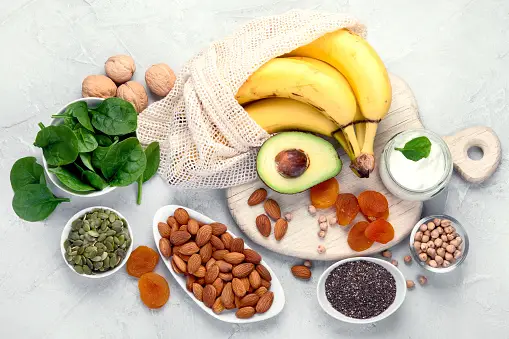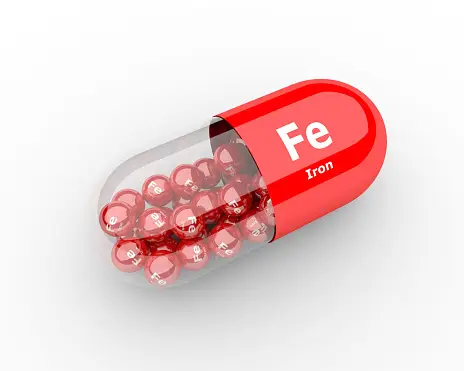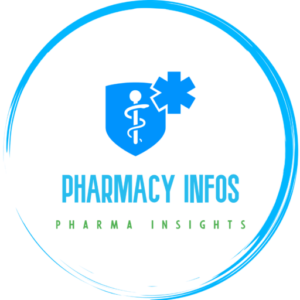Iron deficiency anemia is the erythrocyte disorder occurs due to decreased amount of iron in the blood. Iron plays an important role in the production of hemoglobin. Hemoglobin is the protein responsible for carrying oxygen. Iron deficiency anemia is the most common type compared than other anemic conditions in world wide.
Normal requirement of iron:
In normal daily requirements of iron intake in men is about 1 to 2mg taken from meat and highly colored vegetables. Normal daily requirements for women is about 3mg. The increased amount of iron requirements is necessary for women to compensate for loss of blood during menstruation and to meet the needs of the growing fetus during pregnancy. Children during their period of rapid growth, require more than adults.
Symptom and causes of Iron deficiency anemia:
Fatigue and Weakness: A common and early symptom is feeling tired and weak.
Pale Skin: The reduced hemoglobin levels can lead to paleness, especially in the face, palms, and nail beds.
Shortness of Breath: Inadequate oxygen delivery to tissues may cause difficulty in breathing and shortness of breath, especially during physical activities.
Headache and Dizziness: Inadequate oxygen reaching the brain can result in headaches and dizziness.
Restless Legs Syndrome: Some individuals may experience a crawling or tingling sensation in their legs, especially at night.
Swelling or Soreness of the Tongue and Mouth: The mucous membranes in the mouth and tongue may become inflamed.
Causes:
Inadequate Dietary Intake: Insufficient consumption of iron-rich foods, such as red meat, poultry, fish, beans, and fortified cereals.
Poor Iron Absorption: Certain conditions, like celiac disease or inflammatory bowel diseases, can interfere with iron absorption in the gastrointestinal tract.
Blood Loss: Chronic bleeding from conditions like ulcers, gastritis, hemorrhoids, or heavy menstrual periods can lead to iron loss.
Pregnancy: Pregnant women require more iron to support the growing fetus, and inadequate intake or absorption may lead to deficiency.
Gastrointestinal Surgery: Surgical procedures that remove or bypass parts of the stomach or small intestine can affect iron absorption.
Increased Iron Requirements: Infants, toddlers, and adolescents may experience increased iron needs during periods of rapid growth.
Malabsorption Disorders: Conditions like celiac disease, Crohn’s disease, and other malabsorption disorders can impair the absorption of nutrients, including iron.
Blood Disorders: Conditions like hemolysis or chronic diseases like chronic kidney disease may increase the body’s demand for iron.
Diagnostic methods for Iron deficiency anemia:
Complete Blood Count (CBC):
CBC is a standard blood test that provides information about the number and characteristics of different blood cells. Following tests are performed in CBC.
- Hemoglobin (Hb) levels: Low levels may suggest anemia.
- Mean Corpuscular Volume (MCV): A measure of the average size and volume of erythrocytes. Low MCV may indicate iron deficiency anemia.
- Ferritin levels: Ferritin is one of the protein that stores iron. Low levels suggest depleted iron stores.
- Serum Iron and Total Iron-Binding Capacity (TIBC): These tests measure the amount of iron in the blood and the capacity of proteins to bind to iron. Low serum iron and high TIBC are consistent with iron deficiency anemia.
Endoscopy or Imaging Studies:
If there is suspicion of gastrointestinal bleeding as a cause of iron deficiency, endoscopy or imaging studies like colonoscopy may be performed to identify and address the source.
Dietary plans to overcome iron deficiency anemia:
Heme Iron Sources (Animal-Based):
Red Meat: Beef, lamb, and pork are the best sources of heme iron.
Poultry: Chicken and turkey provide heme iron.
Fish: Certain fish, such as tuna, salmon, and sardines, are good sources of heme iron.
Organ Meats: Liver and other organ meats are particularly rich in heme iron.
Shellfish: Clams, oysters, mussels, and shrimp are good sources of heme iron.
Non-Heme Iron Sources (Plant-Based):
Legumes: Lentils, chickpeas, and beans (black, kidney, navy, pinto, etc.) are rich in non-heme iron.
Tofu and Tempeh: Soy-based products like tofu and tempeh contain non-heme iron.
Nuts and Seeds: Pumpkin seeds, sunflower seeds, almonds, and cashews are good sources of non-heme iron.
Fortified Foods: A few cereals, bread, and plant-based milk options are invigorated with iron.
Whole Grains: Quinoa, brown rice, and oatmeal contain non-heme iron.
Vegetables: Dark leafy greens, such as spinach, kale, and broccoli, provide non-heme iron.

Enhancing Iron Absorption:
Vitamin C-Rich Foods: Consuming fruits and vegetables high in vitamin C (e.g., oranges, strawberries, bell peppers) can enhance non-heme iron absorption.
Avoiding Calcium-Rich Foods During Meals: Calcium can inhibit iron absorption, so it’s advisable to avoid consuming high-calcium foods (e.g., dairy products) with iron-rich meals.
Cooking in Cast Iron Cookware: Cooking acidic foods (e.g., tomatoes) in cast iron cookware can increase the iron content of the food.
Supplements and Treatment Options:
1. Iron Supplements:
Ferrous Sulfate: This is one of the most commonly prescribed iron supplements. It has present in various dosage forms, including tablets and liquid.
Ferrous Gluconate: Another form of iron supplement that may be recommended if ferrous sulfate causes side effects.
Ferrous Fumarate: This is another option for iron supplementation and may be prescribed depending on individual needs and tolerances.
Slow-Release Iron: Some individuals may tolerate slow-release or enteric-coated iron supplements better, as they can cause fewer gastrointestinal side effects.

2. Dosage and Administration:
Timing: Iron supplements are often taken on an empty stomach to enhance absorption. However, they can be hard on the stomach, so taking them with a small amount of food may be advised.
Vitamin C: Taking iron supplements with vitamin C can increase iron absorption. Consider having a glass of orange juice or consuming vitamin C-rich foods with your iron supplement.
Note: Avoiding Interference
Calcium, antacids, and certain medications can interfere with iron absorption. It’s advisable to take iron supplements a few hours apart from these substances.
3. Dietary Changes:
Iron-Rich Foods: Incorporate a variety of iron-rich foods into your diet, including both heme and non-heme sources. (Refer to the previous response for a list of iron-rich foods).
Vitamin C-Rich Foods: Consume fruits and vegetables high in vitamin C to enhance non-heme iron absorption.
Limiting Inhibitors: Avoid consuming tea, coffee, and high-fiber foods close to meals containing iron-rich foods or supplements, as these can inhibit iron absorption.
4. Treating Underlying Causes:
Addressing Blood Loss: If iron deficiency is caused by chronic bleeding, addressing the underlying cause (such as treating ulcers or managing heavy menstrual periods) is crucial.
Managing Gastrointestinal Conditions: If malabsorption or gastrointestinal disorders contribute to iron deficiency, managing these conditions may be necessary.
Monitoring and Follow-Up: Regular blood tests and follow-up appointments with a healthcare provider are essential to monitor iron levels and adjust treatment as needed.
5. Intravenous (IV) Iron:
For Severe Cases: In some cases, intravenous iron may be recommended, especially if oral supplements are not well-tolerated or if there’s a need for rapid iron replenishment.

Pingback: What is anemia? and how to easily overcome it - Pharmacyinfos